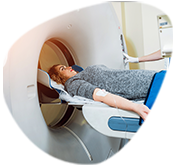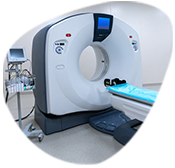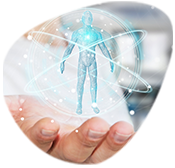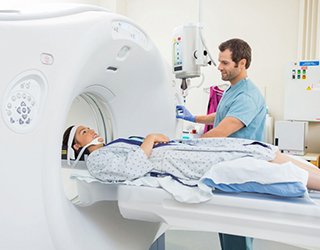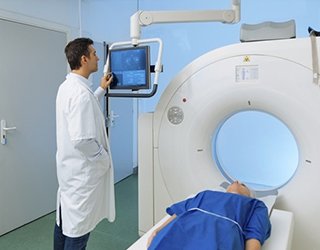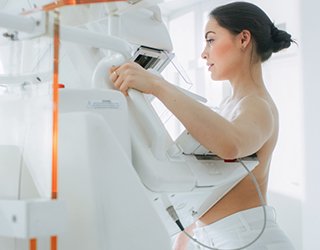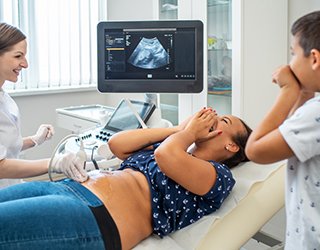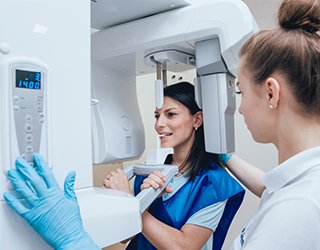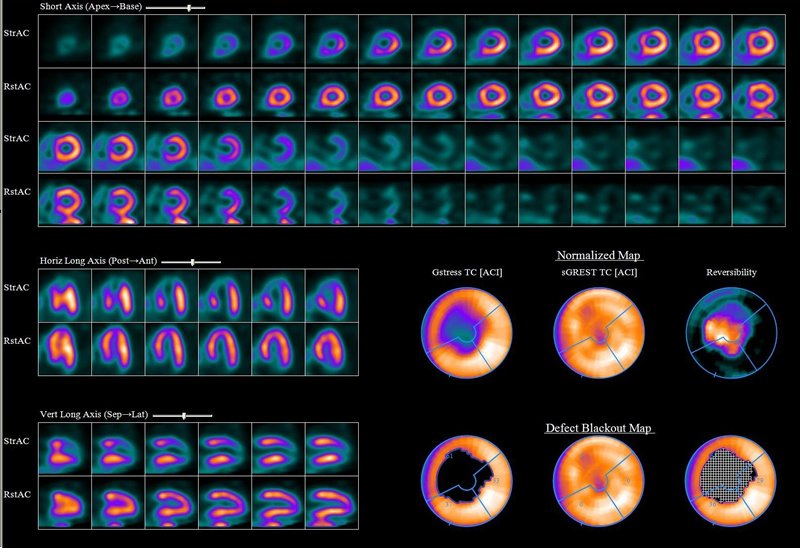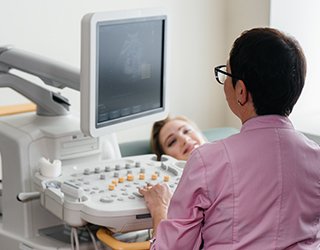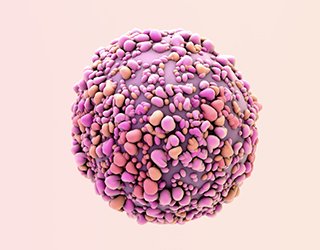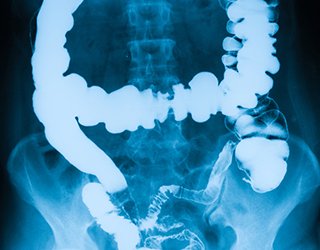Positron Emission Tomography -
Computed Tomography (PETCT)
- Home>
- Positron Emission Tomography – Computed Tomography (PETCT)
Positron emission tomography, also called PET imaging or a PET scan, is a type of nuclear medicine imaging.
Nuclear medicine is a branch of medical imaging that uses small amounts of radioactive material to diagnose and determine the severity of or treat a variety of diseases, including many types of cancers, heart disease, gastrointestinal, endocrine, neurological disorders and other abnormalities within the body. Because nuclear medicine procedures are able to pinpoint molecular activity within the body, they offer the potential to identify disease in its earliest stages as well as a patient’s immediate response to therapeutic interventions.
Nuclear medicine imaging procedures are noninvasive and, with the exception of intravenous injections, are usually painless medical tests that help physicians diagnose and evaluate medical conditions. These imaging scans use radioactive materials called radiopharmaceuticals or radiotracers.
Depending on the type of nuclear medicine exam, the radiotracer is either injected into the body, swallowed or inhaled as a gas and eventually accumulates in the organ or area of the body being examined. Radioactive emissions from the radiotracer are detected by a special camera or imaging device that produces pictures and provides molecular information.
Sample image obtained using a combination of PET and CT imaging technology.
In many centers, nuclear medicine images can be superimposed with computed tomography (CT) or magnetic resonance imaging (MRI) to produce special views, a practice known as image fusion or co-registration. These views allow the information from two different exams to be correlated and interpreted on one image, leading to more precise information and accurate diagnoses. In addition, manufacturers are now making single photon emission computed tomography/computed tomography (SPECT/CT) and positron emission tomography/computed tomography (PET/CT) units that are able to perform both imaging exams at the same time. An emerging imaging technology, but not readily available at this time is PET/MRI.
A PET scan measures important body functions, such as blood flow, oxygen use, and sugar (glucose) metabolism, to help doctors evaluate how well organs and tissues are functioning.
CT imaging uses special x-ray equipment, and in some cases a contrast material, to produce multiple images or pictures of the inside of the body. These images can then be interpreted by a radiologist on a computer monitor. CT imaging provides excellent anatomic information.
Today, almost all PET scans are performed on instruments that are combined PET and CT scanners. The combined PET/CT scans provide images that pinpoint the anatomic location of abnormal metabolic activity within the body. The combined scans have been shown to provide more accurate diagnoses than the two scans performed separately.

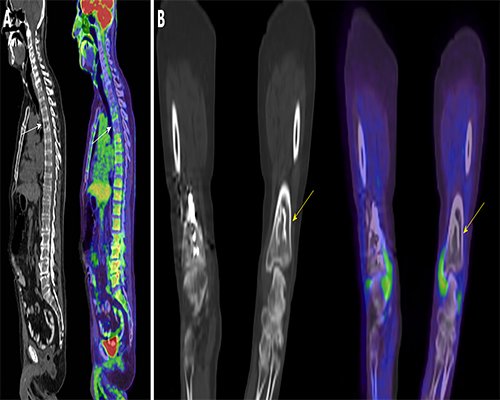
PET and PET/CT scans are performed to:
- Detect cancer.
- Determine whether a cancer has spread in the body.
- Assess the effectiveness of a treatment plan, such as cancer therapy.
- Determine if a cancer has returned after treatment.
- Determine blood flow to the heart muscle.
- Determine the effects of a heart attack, or myocardial infarction, on areas of the heart.
- Identify areas of the heart muscle that would benefit from a procedure such as angioplasty or coronary artery bypass surgery (in combination with a myocardial perfusion scan).
- Evaluate brain abnormalities, such as tumors, memory disorders, seizures and other central nervous system disorders.
- Map normal human brain and heart function.
You may be asked to wear a gown during the exam or you may be allowed to wear your own clothing.
Women should always inform their physician or technologist if there is any possibility that they are pregnant or if they are breastfeeding. See the Safety page for more information about pregnancy and breastfeeding related to nuclear medicine imaging.
You should inform your physician and the technologist performing your exam of any medications you are taking, including vitamins and herbal supplements. You should also inform them if you have any allergies and about recent illnesses or other medical conditions.
You will receive specific instructions based on the type of PET scan you are undergoing. Diabetic patients will receive special instructions to prepare for this exam.
If you are breastfeeding at the time of the exam, you should ask your radiologist or the doctor ordering the exam how to proceed. It may help to pump breast milk ahead of time and keep it on hand for use after the PET radiopharmaceutical and CT contrast material are no longer in your body.
Metal objects including jewelry, eyeglasses, dentures and hairpins may affect the CT images and should be left at home or removed prior to your exam. You may also be asked to remove hearing aids and removable dental work.
Generally, you will be asked not to eat anything for several hours before a whole body PET/CT scan since eating may alter the distribution of the PET tracer in your body and can lead to a suboptimal scan. This could require the scan to be repeated on another day, so following instructions regarding eating is very important. You should not drink any liquids containing sugars or calories for several hours before the scan. Instead, you are encouraged to drink water. If you are diabetic, you may be given special instructions. You should inform your physician of any medications you are taking and if you have any allergies, especially to contrast materials, iodine, or seafood.
You will be asked and checked for any conditions that you may have that may increase the risk of receiving intravenous contrast material.
Women should always inform their physician or technologist if there is any possibility that they are pregnant or if they are breastfeeding. See the Safety page for more information about pregnancy and breastfeeding related to nuclear medicine imaging.
You should inform your physician and the technologist performing your exam of any medications you are taking, including vitamins and herbal supplements. You should also inform them if you have any allergies and about recent illnesses or other medical conditions.
You will receive specific instructions based on the type of PET scan you are undergoing. Diabetic patients will receive special instructions to prepare for this exam.
If you are breastfeeding at the time of the exam, you should ask your radiologist or the doctor ordering the exam how to proceed. It may help to pump breast milk ahead of time and keep it on hand for use after the PET radiopharmaceutical and CT contrast material are no longer in your body.
Metal objects including jewelry, eyeglasses, dentures and hairpins may affect the CT images and should be left at home or removed prior to your exam. You may also be asked to remove hearing aids and removable dental work.
Generally, you will be asked not to eat anything for several hours before a whole body PET/CT scan since eating may alter the distribution of the PET tracer in your body and can lead to a suboptimal scan. This could require the scan to be repeated on another day, so following instructions regarding eating is very important. You should not drink any liquids containing sugars or calories for several hours before the scan. Instead, you are encouraged to drink water. If you are diabetic, you may be given special instructions. You should inform your physician of any medications you are taking and if you have any allergies, especially to contrast materials, iodine, or seafood.
You will be asked and checked for any conditions that you may have that may increase the risk of receiving intravenous contrast material.
Except for intravenous injections, most nuclear medicine procedures are painless and are rarely associated with significant discomfort or side effects.
When the radiotracer is given intravenously, you will feel a slight pin prick when the needle is inserted into your vein for the intravenous line. When the radioactive material is injected into your arm, you may feel a cold sensation moving up your arm, but there are generally no other side effects.
When swallowed, the radiotracer has little or no taste. When inhaled, you should feel no differently than when breathing room air or holding your breath.
With some procedures, a catheter may be placed into your bladder, which may cause temporary discomfort.
It is important that you remain still while the images are being recorded. Though nuclear imaging itself causes no pain, there may be some discomfort from having to remain still or to stay in one particular position during imaging.
If you are claustrophobic, you may feel some anxiety while you are being scanned.
Unless your physician tells you otherwise, you may resume your normal activities after your nuclear medicine scan. If any special instructions are necessary, you will be informed by a technologist, nurse or physician before you leave the nuclear medicine department.
Through the natural process of radioactive decay, the small amount of radiotracer in your body will lose its radioactivity over time. It may also pass out of your body through your urine or stool during the first few hours or days following the test. You should also drink plenty of water to help flush the radioactive material out of your body as instructed by the nuclear medicine personnel.
When the radiotracer is given intravenously, you will feel a slight pin prick when the needle is inserted into your vein for the intravenous line. When the radioactive material is injected into your arm, you may feel a cold sensation moving up your arm, but there are generally no other side effects.
When swallowed, the radiotracer has little or no taste. When inhaled, you should feel no differently than when breathing room air or holding your breath.
With some procedures, a catheter may be placed into your bladder, which may cause temporary discomfort.
It is important that you remain still while the images are being recorded. Though nuclear imaging itself causes no pain, there may be some discomfort from having to remain still or to stay in one particular position during imaging.
If you are claustrophobic, you may feel some anxiety while you are being scanned.
Unless your physician tells you otherwise, you may resume your normal activities after your nuclear medicine scan. If any special instructions are necessary, you will be informed by a technologist, nurse or physician before you leave the nuclear medicine department.
Through the natural process of radioactive decay, the small amount of radiotracer in your body will lose its radioactivity over time. It may also pass out of your body through your urine or stool during the first few hours or days following the test. You should also drink plenty of water to help flush the radioactive material out of your body as instructed by the nuclear medicine personnel.
Benefits
Risks
- Nuclear medicine examinations offer information that is unique—including details on both function and structure—and often unattainable using other imaging procedures.
- For many diseases, nuclear medicine scans yield the most useful information needed to make a diagnosis or to determine appropriate treatment, if any.
- Nuclear medicine is less expensive and may yield more precise information than exploratory surgery.</li
- By identifying changes in the body at the cellular level, PET imaging may detect the early onset of disease before it is evident on other imaging tests such as CT or MRI.
- For additional benefits of CT exams, see Computed Tomography (CT) at The benefits of a combined PET/CT scanner include:
- Greater detail with a higher level of accuracy; because both scans are performed at one time without the patient having to change positions, there is less room for error.
- Greater convenience for the patient who undergoes two exams (CT & PET) at one sitting, rather than at two different times.
Risks
- Because the doses of radiotracer administered are small, diagnostic nuclear medicine procedures result in relatively low radiation exposure to the patient, acceptable for diagnostic exams. Thus, the radiation risk is very low compared with the potential benefits.
- Nuclear medicine diagnostic procedures have been used for more than five decades, and there are no known long-term adverse effects from such low-dose exposure.
- The risks of the treatment are always weighed against the potential benefits for nuclear medicine therapeutic procedures. You will be informed of all significant risks prior to the treatment and have an opportunity to ask questions.
- Allergic reactions to radiopharmaceuticals may occur but are extremely rare and are usually mild. Nevertheless, you should inform the nuclear medicine personnel of any allergies you may have or other problems that may have occurred during a previous nuclear medicine exam.
- Injection of the radiotracer may cause slight pain and redness which should rapidly resolve.
- Women should always inform their physician or radiology technologist if there is any possibility that they are pregnant or if they are breastfeeding.
Other Guidlines


